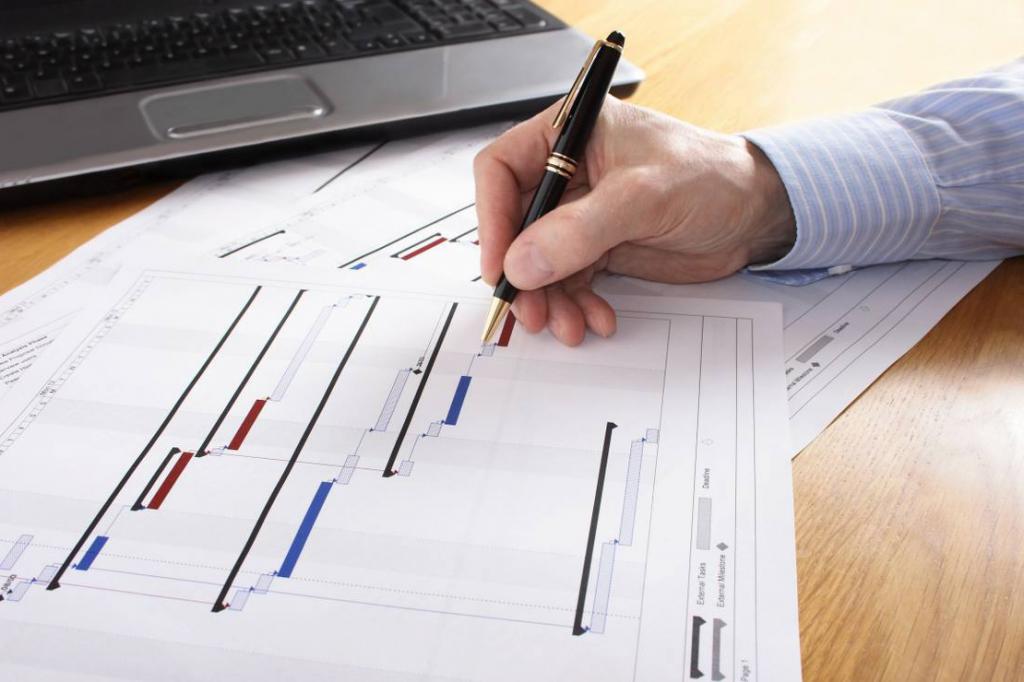The essence of design is to develop a strategy for achieving specific goals. A model is being created in accordance with which these or those actions are phased to bring closer to the final result. But project planning as such requires careful analysis and elaboration, so that the strategy for solving the problem involves the use of optimal tools and methods that will increase the chances of success in achieving goals.
The concept and purpose of planning
Even before the start of direct design, a concept, principles and model are being formed, according to which an action plan will be developed. This is the basis on which the system of focused steps aimed at achieving results is built. The result is understood as the ultimate goal for which a design solution is being developed. Initially, a framework of the organizational structure is created, within the framework of which the order, sequence and nature of the work are approved. The tasks of project planning are also posed, in which the tactics of using material and technical resources can also be revealed. Directly planning covers all phases of creating a design solution, but this does not mean that they should be developed according to a single model. At each stage, an individual approach can be applied, taking into account the specifics of work actions and the complexity of their implementation. However, the stages of the project should be structured in the overall planning system.

The model by which the project will be developed, in any case, is built with an emphasis on achieving the final result. Only in this case will it be possible to count on creating an optimal management strategy for quality. An important role is played by input data, which can introduce rules, principles or restrictions, the significance of which will become apparent after the implementation of the project. At the same time, the goal of project planning should be determined, which will be to create the optimal model of action in terms of implementing the task.
Domain Planning
One of the initial stages of planning, during which part of the fundamental parameters of the project is determined. In this case, the subject area is understood as a set of goals and objectives, the achievement of which should be implemented in the process of completing the project. Moreover, if specific directions of step-by-step movement toward a goal set quite definite achievement points in terms of measured parameters, then the subject area is defined as a wider infrastructure of the final goal. It may also affect factors that will manifest themselves during the operation of a product or a developed technological solution. What exactly at the initial stage can project planning take into account the subject area? This model allows you to perform the following tasks:
- Based on the analysis of goals, the current state of the control system is specified.
- Clarification of the key parameters of the design decision.
- Detailed formulation of the criteria for success and failure.
- Analysis and adjustment of constraint assumptions.
- Determining the parameters for evaluating the intermediate and final results of the project
The composition of the planning processes

As the plan is developed, its creators move from the general formulation and technical justification of goals to a detailed description of the activities that will need to be completed to achieve specific goals.And again, it is impossible to consider the system of forming the organizational structure of the plan as closed even after the integration of input data. Even without the external receipt of new information, there may be a need for additional information or clarification of previous data. For the same reason, project planning processes have a cyclic property. Repetition is necessary for the operation taking into account the updated data.
At the same time, each iteration should initially have a clear sequence of execution - both in separate stages and within the framework of the general planning model. Specific processes include the following:
- Development of the structure of the content of the project indicating the main stages of the project.
- Breakdown of large tasks into small ones - detailing and segmentation into separate processes.
- Drawing up an estimate design, which will take into account the required resources for both planning and project development.
- Drawing up a list of specific work activities. Formation of a document base in which the parameters of the work, their technological dependencies, etc. will be indicated
- Arrangement of work activities in the overall planning structure. Determining the possibilities of changing the configuration of their implementation.
Depending on the complexity of the execution, the project planning system may include different sets of supporting processes. Among the most common among them are the development of control and quality standards, the determination of the status of subordination and responsibility, the preparation of the required media and communication. Also, during planning, there may arise needs for new processes that are not provided for at the stage of formulating goals and objectives.
Stages of creating a schedule

Regardless of the chosen planning tactics, the management department will need to develop a structure with the content of the work, indicating the risks and limitations. But it will not be possible to determine a specific model of movement toward a goal without scheduling the project, which consists of the following steps:
- Determining the scope of work using the list. The operational list, which reflects the sequence of steps in the implementation of the task by one method or another.
- Each task and the attached work are assigned runtime parameters taking into account the limitations on the resources expended. At this stage, the method of decomposition of tasks with a parallel assessment of the duration of work is usually used.
- A focused stage to determine the availability and volume of the resource base. An extensive list of types of resources can be taken into account, including informational, technological, labor and financial.
- Setting limits. As a rule, this applies to external factors depending on the season, logistic processes, random events, etc.
In this plan structure, it is worth highlighting the stages associated with risks and limitations. The quality of project management planning will depend on the initially approved ways of responding to certain factors. In particular, there are two ways of responding - active and passive. In the first case, the project lays down tactics of actions that minimize the very probability of the occurrence of risks. A passive strategic response is based on the assumption of risks, as well as compensation for contingent damage from the consequences of their implementation.
Methods for developing plans
Creating a management strategy allows for the application of four development methods, each of which can be applied at several stages of project planning
- Conceptual. In this case, the design decision can be considered as a means of achieving a common goal, in the implementation of which all participants in the system will participate.In accordance with the conceptual strategy, the project is divided into several separate stages, each of which represents a specific task with its own achievement tactics, limitations and necessary resources.
- Strategic planning. It is based on the intended goals and objectives, providing for the analysis of alternative ways to achieve results. This plan is characterized by taking into account a wide range of various factors and nuances of project development, in which the positive and negative sides of different paths to the goal are evaluated. The main criteria for eligibility are implementation timelines, project costs and organizational efforts.
- Tactical plan. It features a high degree of detail and refinement of strategic objectives. During development, individual project planning processes, deadlines, volumes of work, and resources expended may be corrected.
- Operational plan. It is usually used as an auxiliary solution in relation to the general planning process. It is built for a short-term analysis period taking into account the identified deviations from the planned parameters.
Resource Planning Features

Logistical, informational and organizational support in the processes of preparation and implementation of projects are of great importance. They largely determine the configuration and sequence of the individual steps and operations on the path to achieving both the main and intermediate tasks. Therefore, it is worthwhile to separately consider the method of project planning from the perspective of the distribution of the resource base. So, the structural development of this planning model will be based on the classification of resources by exhaustibility. It must immediately be determined that the same material and technical means can be fully or partially given up for the implementation of a separate stage. The principle of rational consumption and redistribution of resources will also affect here, in which competent planning will allow you to effectively consume, for example, fuel in some areas, and save it on others.
An essential factor in the resource planning of the project is the need, which is determined through the intensity of costs. The working phase will depend on the amount of spent raw materials. As a result, together with the duration of the execution of a particular operation, the value of the required resource base will also be indicated. Of course, depending on the nature of the task, several types of resources may be spent on one operation.
Planning stages of the project

The group of control processes is involved, which closes the planning, leaving additional materials and guidance on the implementation of the project. This part takes into account the factors of coordination, responsiveness and leadership qualities of the performer or team of performers. So, the project implementation planning involves the development of the following stages:
- Team building. Specialists and experts of the necessary profiles are involved, who, in principle, possess technologies for performing similar tasks.
- Selection of counterparties. These may be suppliers of certain goods, partners or third-party teams that provide certain services necessary for the implementation of the project.
- Development of conditions for quality control of the work performed. A set of technical conditions can be developed with a focus on existing standards in the target area.
- Creating a coordination model between different participants in the project implementation process
Project Risk Planning

The importance of pre-creating a risk response model has already been discussed. A specific model of their processing can be based on the following response mechanisms:
- Determining the likelihood of risks. An interest system or an individual one can be used, with its own evaluation criteria.
- Determining the nature of the risks.
- Calculation of the degree of influence of a specific risk for the project as a whole.
- The classification of risks according to priority in terms of impact on the project.
- Development of a set of measures that will prevent a particular threat to the project. Planning work in this direction provides for the creation of a system for appointing those responsible for each event.
- Development of model actions to eliminate the consequences of a risk event.
Common planning errors
Many miscalculations in various factors and parameters of creating a plan can occur only during the operation of the designed product or solution. But there are also model errors with which it is better to correlate prepared project materials in advance:
- Applying the wrong goals. As a rule, errors in this part are expressed in inaccurate or completely incorrect formulation.
- Use of incomplete data. Mistakes in project management planning are especially common in engineering industries, where it is likely to receive incomplete or incorrect data due to irregularities in complex testing processes.
- Connecting a narrow group of specialists. Often, only planners are involved in the work, who solve related tasks through counterparties, which in itself reduces the quality of the result.
- Formalization of planning. A common problem when individual processes are performed not for clear concrete purposes, but to complete a certain part of the work without emphasis on the further effect.
Conclusion

Vision of the image of the structure of the plan for the implementation of actions that bring it closer to the ultimate goal is very significant for participants in the design processes. This allows you to take into account the whole range of nuances and factors that, to one degree or another, affect the course of work. Therefore, a strategic resource is laid on the preparation of a concept for further development. At a minimum, principles for the implementation of the tasks are formulated. Only with this approach can we count on the successful achievement of the ultimate goals. In addition, a deep planning analysis makes it possible to significantly optimize the project, which is beneficial from the economic point of view for the customer.
